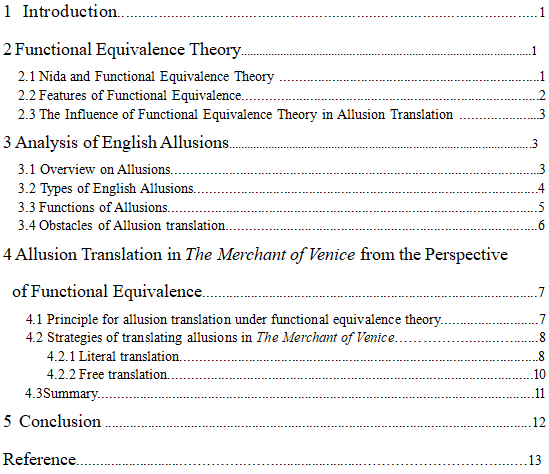
| 文档价格: | 1000金币立即充值 | 包含内容: | 完整论文 | 文章下载流程 | |||||
| 文章字数: | 6034 字 (由Word统计) | 文章格式: | Doc.docx (Word) | 本站文章可以通过查重吗? |
功能对等理论视角下的典故翻译-以《威尼斯商人》为例_英语论文
On the Translation of Allusions in The Merchant of Venice from the Perspective of Functional Equivalence
摘要
英文典故在英语文学作品中占有很重要的地位,它种类丰富,涉及到宗教,希腊罗马神话,历史故事,文学作品等。典故简洁精炼,语义深邃,富有表现力,被广泛应用于各种文体,但典故与文化息息相关,蕴含丰富的文化内涵,通常很含蓄,所以不太容易被读者理解,这就需要更为贴近读者的翻译。
在这种要求下,奈达的功能对等理论更关注读者反应,所以就更加实用。本文以功能对等理论为基本理论,举例《威尼斯商人》三个翻译版本,一个是朱生豪翻译的版本,一个是方平的版本还有梁实秋的版本。研究其中的典故翻译,有利于帮助读者理解。
关键词:功能对等理论;威尼斯商人;典故;翻译
Abstract
English allusions play an important role in English literature, and they are very rich, involving religion, Greek and Roman mythology, historical stories, literary works and so on. They are also used in all kinds of styles concisely, profoundly and expressively. However, English allusions is closely related with culture and contain abundant cultural connotations with subtle meaning. It will be a little difficult for readers to understand, so it is very important to find the translation which is much closer to readers.
In this case, Nida’s Functional Equivalence Theory which is concerned more about the readers’ reaction will be more practical. This paper takes it as the basic theory. There are three translation versions of The Merchant of Venice: Zhu Shenghao’s version, Fang Ping’s version and Liang Shiqiu’s version, which are the classical cases to study the allusion translation from the perspective of the Functional Equivalence Theory. It will help readers understand the allusions.
Key words: functional equivalence theory; The Merchant of Venice; allusion; translation
